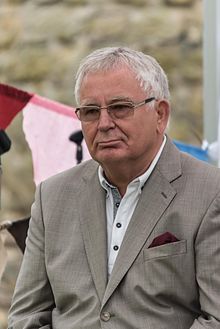Tiit Vähi
Tiit Vähi | |
|---|---|
 Vähi in 2016 | |
| 11th Prime Minister of Estonia | |
| In office 17 April 1995 – 17 March 1997 | |
| President | Lennart Meri |
| Preceded by | Andres Tarand |
| Succeeded by | Mart Siimann |
| 2nd Prime Minister of the Interim Government | |
| In office 29 January 1992 – 21 October 1992 | |
| President | Arnold Rüütel as Chairman of the Supreme Council Lennart Meri |
| Preceded by | Edgar Savisaar |
| Succeeded by | Mart Laar as Prime Minister |
| Personal details | |
| Born | 10 January 1947 Kaagjärve Parish, Tallinn Technical University |
Tiit Vähi (born 10 January 1947) is an
Life and career
Born in Kaagjärve Parish,
During the Estonian national independence movement, Vähi was among the organisers of the
Shortly after Estonia's return to independence in 1991, Vähi was appointed as the Government's special representative to north-eastern Estonia, a region inhabited by a majority of ethnic Russians.
On 29 January 1992, Vähi became the second post-
As agreed when he assumed the post of prime minister in the transition government, Vähi did not participate in the parliamentary elections on 20 September 1992.
In 1993, he was elected Chairman of the Estonian Coalition Party. The parliamentary elections of March 1995 gave victory to the KMÜ coalition, comprising the Estonian Coalition Party and the People's Union of Estonia Parties. As leader of the Estonian Coalition Party, Vähi was asked by President Lennart Meri to form a government. Appointed Prime Minister for the second time in his career, he formed a coalition government of the KMÜ and the Estonian Centre Party, which was sworn in on 17 April 1995.[2]
His second term as prime minister was quite rocky. On 11 October 1995 several ministers resigned from the cabinet, causing the
References
- ^ "Intervjuu: Tiit Vähi võib tööjuttu ajada ka kell kaks öösel". 28 January 2017.
- ISBN 978-0-8179-2852-0
- ^ Tapes Scandal Topples Rulers in Estonia. The Washington Post. 12 October 1995 link
- ^ Estonia Names New Prime Minister The Washington Post. 28 February 1997 link
- ^ Vähi: Venemaa vastane sõjatõrvik kahjustab äri

